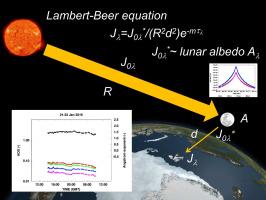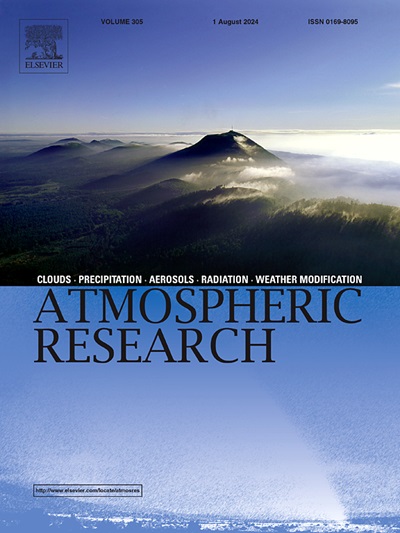Monitoring aerosol optical depth during the Arctic night: Instrument development and first results
IF 4.5
2区 地球科学
Q1 METEOROLOGY & ATMOSPHERIC SCIENCES
引用次数: 0
Abstract
Moon-photometric measurements were made at two locations in the Arctic during winter nights using two different modified Sun photometers; a Carter Scott SP02 and a Precision Filter Radiometer (PFR) developed at PMOD/WRC. Values of aerosol optical depth (AOD) were derived from spectral irradiance measurements made at four wavelengths for each of the devices. The SP02 was located near Barrow, Alaska and recorded data from November 2012 to March 2013, spanning five lunar cycles, while the PFR was deployed to Ny-Ålesund, Svalbard each winter from February 2014 to February 2019 for a total of 56 measurement periods. A methodology was developed to process the raw data, involving calibration of the instruments and normalizing measured spectral irradiance values in accordance with site-specific determinations of the extraterrestrial atmospheric irradiance (ETI) as Moon phase cycled. Uncertainties of the derived AOD values were also evaluated and found to be in the range, 0.006–0.030, depending on wavelength and which device was evaluated.
The magnitudes of AOD determined for the two sites were in general agreement with those reported in the literature for sunlit periods just before and after the dark periods of Arctic night. Those for the PFR were also compared with data obtained using star photometers and a Cimel CE318-T, recently deployed to Ny-Ålesund, showing that Moon photometry is viable as a means to monitor AOD during the Arctic night. Such data are valuable for more complete assessments of the role aerosols play in modulating climate, the validation of AOD derived using various remote sensing techniques, and applications related to climate modeling.

北极夜间气溶胶光学深度监测:仪器开发和初步结果
利用卡特-斯科特 SP02 和 PMOD/WRC 开发的精密滤光辐射计(PFR)这两种不同的改进型太阳光度计,在北极的两个地点进行了冬夜月光测量。气溶胶光学深度(AOD)值是通过对每种设备的四个波长进行光谱辐照度测量得出的。SP02 位于阿拉斯加巴罗附近,记录了 2012 年 11 月至 2013 年 3 月期间的数据,跨越了五个月球周期;而 PFR 则于 2014 年 2 月至 2019 年 2 月期间的每个冬季部署在斯瓦尔巴特群岛的 Ny-Ålesund,共计 56 个测量周期。制定了一套处理原始数据的方法,包括校准仪器,并根据月相周期中特定地点确定的地外大气辐照度(ETI)对测得的光谱辐照度值进行归一化处理。还对得出的 AOD 值的不确定性进行了评估,发现其范围在 0.006-0.030 之间,具体取决于波长和评估的设备。此外,还将 PFR 的数据与使用星光光度计和最近部署在 Ny-Ålesund 的 Cimel CE318-T 获得的数据进行了比较,结果表明月球光度计是监测北极夜间 AOD 的可行方法。这些数据对于更全面地评估气溶胶在调节气候方面的作用、验证利用各种遥感技术得出的AOD以及与气候建模有关的应用都很有价值。
本文章由计算机程序翻译,如有差异,请以英文原文为准。
求助全文
约1分钟内获得全文
求助全文
来源期刊

Atmospheric Research
地学-气象与大气科学
CiteScore
9.40
自引率
10.90%
发文量
460
审稿时长
47 days
期刊介绍:
The journal publishes scientific papers (research papers, review articles, letters and notes) dealing with the part of the atmosphere where meteorological events occur. Attention is given to all processes extending from the earth surface to the tropopause, but special emphasis continues to be devoted to the physics of clouds, mesoscale meteorology and air pollution, i.e. atmospheric aerosols; microphysical processes; cloud dynamics and thermodynamics; numerical simulation, climatology, climate change and weather modification.
 求助内容:
求助内容: 应助结果提醒方式:
应助结果提醒方式:


